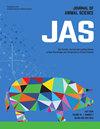Use of Biotics in Animals: Impact on Nutrition, Health, and Food Production
IF 2.7
2区 农林科学
Q1 AGRICULTURE, DAIRY & ANIMAL SCIENCE
引用次数: 0
Abstract
Probiotics, prebiotics, and other biotic substances are not only effective ways to promote a healthy gastrointestinal tract, an effective immune system, and the overall health of humans, but also in agricultural and companion animals. Because key differences exist in regard to gastrointestinal tract anatomy and physiology, dietary management and feeding strategy, and disease susceptibility, however, biotic types and amounts often differ according to host species and life stage. Despite these differences, the literature demonstrates the value of biotics in agricultural and companion animal species. While high variability in responsiveness and efficacy has been reported, biotic substances may be effectively used to improve digestion, reduce morbidity, and increase growth rate and/or efficiency in agricultural animals and promote gastrointestinal health and immune response in companion animals. As the oversight of antibiotic use intensifies, population density of animals and humans increases, and production strategies of agricultural animals are more heavily scrutinized, the importance of biotics and other health promotors will continue to increase in the future. To date, the effects of animal biotic use has focused primarily on the farm, home, or veterinary clinic. In the future, their impact must be viewed on a larger scale. As global “One Health” approaches seek to reduce antimicrobial use and resistance and there are increasing demands for sustainable and safe food production, biotics will continue to be an important part of the solution. As knowledge of gastrointestinal microbiomes grows and the biotic field develops, more targeted and effective strategies for health promotion in these species is expected. At the 2023 International Scientific Association for Probiotics and Prebiotics meeting, experts were invited to participate in a discussion group focused on ‘The Use of Probiotics and Prebiotics in Agricultural and Companion Animals’. This review reports the outcomes of that discussion, including the documented use of probiotics, prebiotics, and other biotic substances to promote health or treat disease in agricultural and companion animals, provide implications of animal biotic use on human health, and provide perspective on how scientific advances may impact the development and improvement of biotics in the future.求助全文
约1分钟内获得全文
求助全文
来源期刊

Journal of animal science
农林科学-奶制品与动物科学
CiteScore
4.80
自引率
12.10%
发文量
1589
审稿时长
3 months
期刊介绍:
The Journal of Animal Science (JAS) is the premier journal for animal science and serves as the leading source of new knowledge and perspective in this area. JAS publishes more than 500 fully reviewed research articles, invited reviews, technical notes, and letters to the editor each year.
Articles published in JAS encompass a broad range of research topics in animal production and fundamental aspects of genetics, nutrition, physiology, and preparation and utilization of animal products. Articles typically report research with beef cattle, companion animals, goats, horses, pigs, and sheep; however, studies involving other farm animals, aquatic and wildlife species, and laboratory animal species that address fundamental questions related to livestock and companion animal biology will be considered for publication.
 求助内容:
求助内容: 应助结果提醒方式:
应助结果提醒方式:


